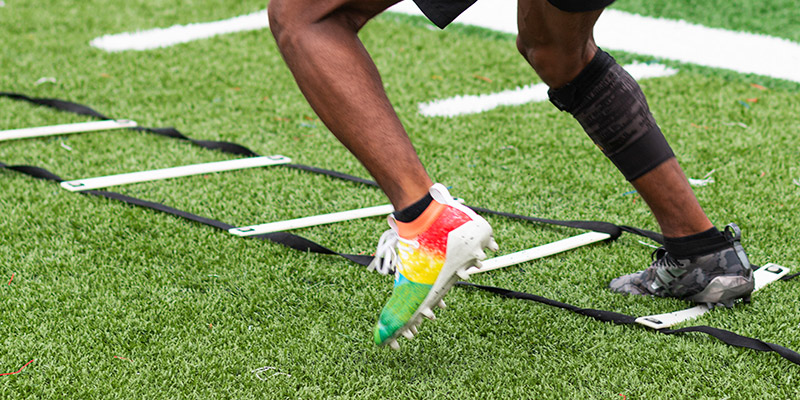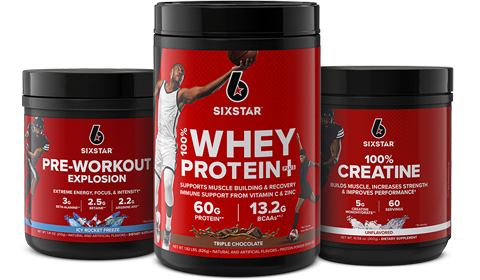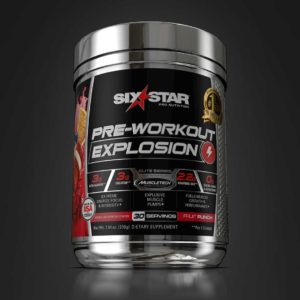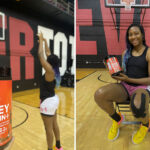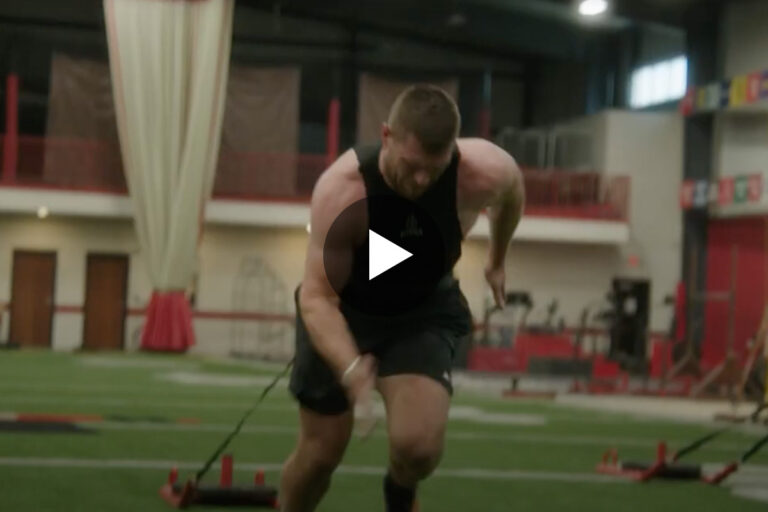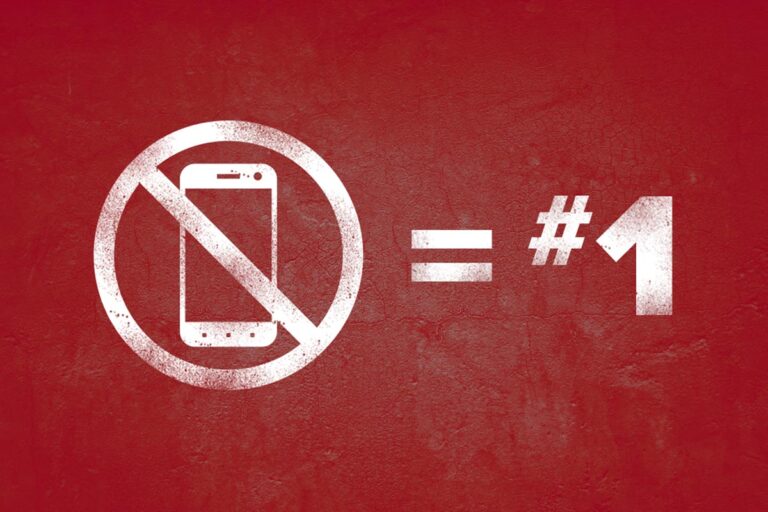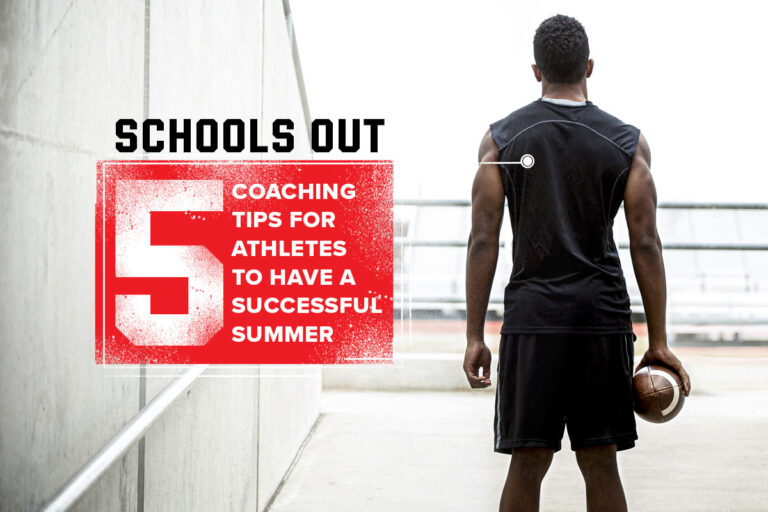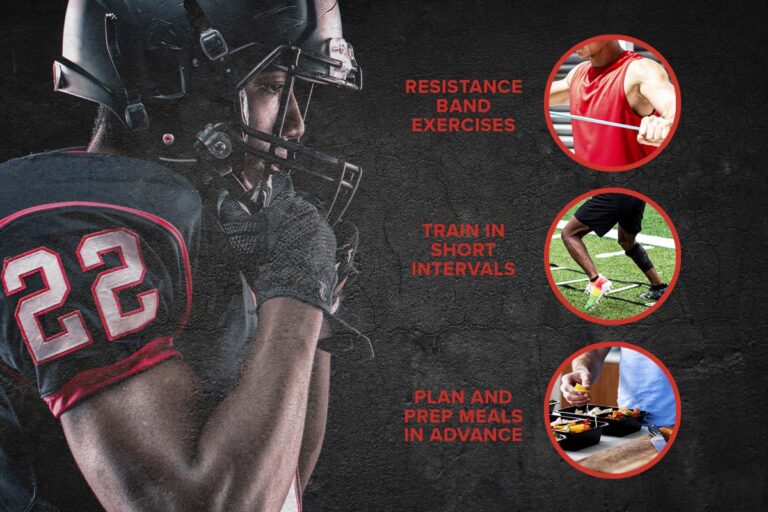Football is one of the most physically and mentally demanding sports to play. In fact, football was named the third most difficult sport by a panel of experts, trailing behind only boxing and ice hockey.
Football players need to be strong and powerful, but also fast and agile. They have to react quickly and make crucial decisions in less than a second. Since there are so many things happening in such a short amount of time on any given football play, you need to make sure that you’re doing the work ahead of time in order to be prepared come game day. This football weight training program will help you strengthen your upper and lower body, while the football drills will enhance your speed, agility, and reaction time.
Sports nutrition supplements like Six Star’s Pre-Workout Explosion can provide extra energy and focus prior to your workout, while Six Star 100% Whey Protein Plus can support your recovery and help build muscle and increase strength.
FOOTBALL WEIGHT TRAINING PROGRAM
LOWER BODY
The Barbell Back Squat: The barbell back squat builds leg strength, develops your posterior chain, and works every major muscle in your lower body. To do a barbell back squat, take the bar out of the rack and position the bar so it’s resting on the muscles on the top of your back. Take two steps back and stand with your feet shoulder-width apart, and your toes pointing slightly out. Lower your body as if you’re trying to sit in a chair, descending until your hip crease is below your knee. Keep your weight on your heels as you drive back up, and make sure not to lock your knees when you stand up. Then repeat the movement. To keep your spine in alignment, focus on a spot on the wall in front of you.
Trap Bar Deadlift: Trap bar deadlifts increase lower body strength and muscle mass, while relieving some strain/stress on your lower back. This is important since the lower back is an injury prone area for weight lifters. To do this exercise, stand with your feet hip-width apart, bending from your knees and hips to grip the trap bar with your arms straight, back flat, hips back, and eyes focused straight ahead. From this position, brace your core and forcefully push through the ground, letting your hips and shoulders rise at the same time to extend your knee and hip while maintaining good posture. Return the bar to the ground slowly, and then reset to the starting to position.
Glute-Ham Raise: After you do squats or deadlifts, it’s a good idea to do glute-ham raises, which hit your entire posterior chain. Glute-ham raises will strengthen your hamstrings, glutes, and lower back, which will help you run faster and jump higher. Glute-ham raises are usually performed using a specialized machine created for this exercise. It’s important to set the machine up properly before beginning. When you’re comfortable and ready, place your knees on or directly behind the pad with your feet flat against the platform. The back of your calves should be resting against the top ankle hook. Start facedown with your body at a 90-degree angle to the floor. Fold your arms across your chest and squeeze your glutes, abs, and hamstrings. Then slowly push your knees in a controlled movement into the pad while contracting your hamstrings to raise your torso, making your torso parallel to the floor. Then move back to the starting position. Push your toes into the foot plate as you raise your body back up to a 90-degree angle, using your hamstrings to help pull you back up. Keep your back as straight as possible throughout the movement.
UPPER BODY
Barbell Rows: To increase back strength and protect your shoulders, barbell rows should become part of your weightlifting routine. Load a barbell in a rack with weights that are appropriate for you. With your hands shoulder-width apart, use an overhand grip to grab the bar. Bend your knees slightly and push your butt back, shifting your torso as you do this. Rest the bar at the bottom of your thighs and make sure that your hamstrings are engaged, your core is tight, your shoulders are on a higher plane than your butt, and your shins are perpendicular to the ground. Squeeze your shoulder blades and then bend at the shoulders and elbows, pulling the bar upwards and back, trying to touch it to your torso (a few inches above your belly button). Your elbows should maintain a 45-degree angle from your body and you should be pulling mostly with your upper arm. Pause when the bar touches your torso (or gets close to it) and then return to the start. After your warm up, you should start your workout session with barbell rows since it’s a muscularly taxing compound exercise. Aim to do barbell rows twice a week in order to create body symmetry and increase your overall strength.
Bench Press: The bench press is a popular upper body exercise that will help improve your blocking and tackling by making your chest, triceps, and shoulders stronger. Lie back on a flat bench holding a barbell in the rack above you with a shoulder-width, overhand grip. Plant your feet on the floor, and contract your quads and glutes. From the starting position, breathe in and lower the bar in a slow and controlled fashion until it touches the middle of your chest. As you do this movement, focus your mind on activating your chest muscles. Then push the bar back to the starting position with power as you breathe out.
Overhead/Military Press: This shoulder pressing exercise will increase shoulder strength and improve your blocking and tackling. It’s important to note that you shouldn’t go straight into the overhead/military press, or any of these other exercises, without warming up properly first. To do the overhead/military press, place a barbell on a squat rack about chest height. Grab the bar with your hands slightly wider than shoulder-width, and your palms facing out. The bar should be resting in the middle of your hands, not on your fingers. At the starting position, the barbell should be just above your deltoids. The difference between the overhead press versus the military press is the way your feet are set up. For the overhead press, your feet should be shoulder-width apart. For the military press, your feet should be together, which will make this movement more difficult. Create full-body tension by tightening your core and pushing your heels into the ground. With the bar level with your chin, make sure your elbows are pointing forward rather than flaring out to your sides. Take a sharp breath in, tense your glutes and torso, and drive the bar straight up, breathing out as you press. Move your hips forward a little as you press the barbell overhead so the load is as close to your center of gravity as possible. Make sure to do this while the barbell is passing by your head because if you do it too early you may hit your head on the barbell. Pause for a count at the top of the exercise. As you lower the bar to chin level, move your head back slightly so you don’t hit your forehead on the way down. Allow your hips to pull back a bit in order to allow the barbell to return to the starting position. Keep your core tensed throughout the set.
FOOTBALL DRILLS
For Agility: The pro agility shuttle is a common agility drill used by coaches and scouts at football combines. It’s good for overall agility, speed, and lateral quickness. The pro agility shuttle (5-10-5 test) requires three cones – one at the start, the second cone five yards to the right, and the third cone placed five yards to the left of the starting cone. Start in a three-point stance and sprint five yards to the right and touch the ground. Then shift directions and sprint 10 yards to the left before touching the ground again. Finish by running the final five yards to the right.
For Speed: The speed ladder change-of-direction drill helps you to develop faster feet and the ability to turn and run on a dime. To do this drill, lay down a speed ladder in an open area. Set up a pair of cones as your finish line eight to 10 yards beyond the end of the speed ladder. Start at the beginning of the speed ladder and either backpedal or move laterally through the ladder. Follow the same pattern throughout – two feet in, two feet out. Once you complete the final rung of the ladder, turn and accelerate through the finish line.
For Reaction: The medicine ball with quick feet drill is designed to enhance cognitive processing (thinking) and cognitive operation (remembering). You’ll need a partner, different colored medicine balls (or objects), and a timer for this drill. Place the different colored medicine balls (or objects) in a circle, or some other shape on the floor. Have your partner set a timer and call a color for where they want you to begin. Then have your partner call out different colors, which you’ll have to find, run to, and perform quick toe taps, lightly touching the correct colored medicine ball. Have your partner keep the reaction going by calling out various colors until your time is up. You can do this drill for 30 seconds at first and then extend it to 60 seconds once you’re more comfortable with it.
